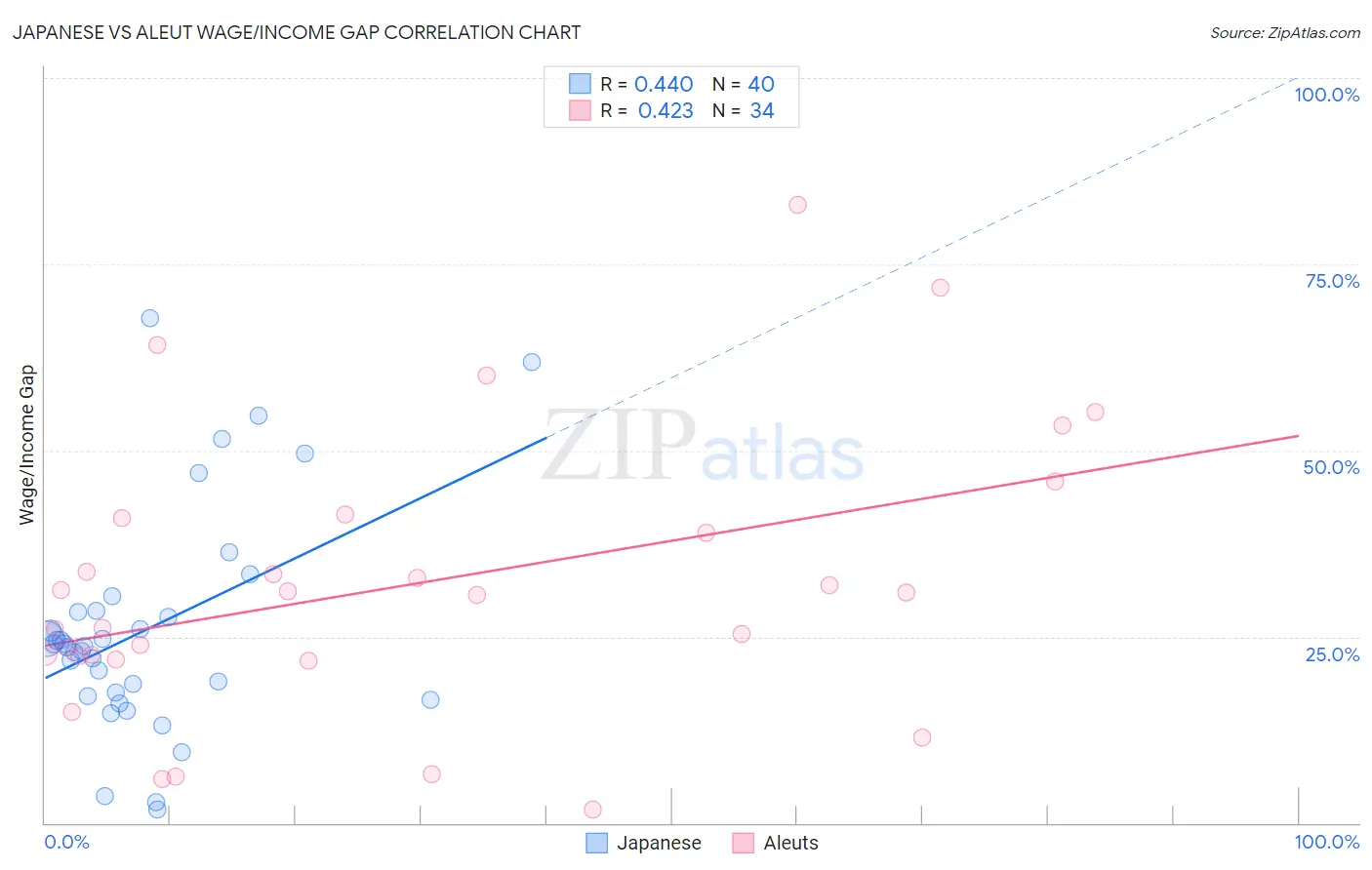Japanese vs Aleut Wage/Income Gap
COMPARE
Japanese
Aleut
Wage/Income Gap
Wage/Income Gap Comparison
Japanese
Aleuts
23.8%
WAGE/INCOME GAP
99.1/ 100
METRIC RATING
101st/ 347
METRIC RANK
23.7%
WAGE/INCOME GAP
99.2/ 100
METRIC RATING
99th/ 347
METRIC RANK
Japanese vs Aleut Wage/Income Gap Correlation Chart
The statistical analysis conducted on geographies consisting of 249,130,971 people shows a moderate positive correlation between the proportion of Japanese and wage/income gap percentage in the United States with a correlation coefficient (R) of 0.440 and weighted average of 23.8%. Similarly, the statistical analysis conducted on geographies consisting of 61,745,679 people shows a moderate positive correlation between the proportion of Aleuts and wage/income gap percentage in the United States with a correlation coefficient (R) of 0.423 and weighted average of 23.7%, a difference of 0.17%.

Wage/Income Gap Correlation Summary
| Measurement | Japanese | Aleut |
| Minimum | 1.7% | 1.9% |
| Maximum | 67.8% | 83.0% |
| Range | 66.0% | 81.1% |
| Mean | 26.0% | 32.2% |
| Median | 23.9% | 30.8% |
| Interquartile 25% (IQ1) | 17.2% | 22.4% |
| Interquartile 75% (IQ3) | 28.4% | 41.0% |
| Interquartile Range (IQR) | 11.2% | 18.6% |
| Standard Deviation (Sample) | 14.8% | 18.9% |
| Standard Deviation (Population) | 14.6% | 18.6% |
Demographics Similar to Japanese and Aleuts by Wage/Income Gap
In terms of wage/income gap, the demographic groups most similar to Japanese are Immigrants from Laos (23.8%, a difference of 0.14%), Yakama (23.7%, a difference of 0.15%), Immigrants from Latin America (23.7%, a difference of 0.25%), Tsimshian (23.9%, a difference of 0.37%), and Immigrants from Sudan (23.6%, a difference of 0.64%). Similarly, the demographic groups most similar to Aleuts are Yakama (23.7%, a difference of 0.020%), Immigrants from Latin America (23.7%, a difference of 0.070%), Immigrants from Laos (23.8%, a difference of 0.32%), Immigrants from Sudan (23.6%, a difference of 0.47%), and Tsimshian (23.9%, a difference of 0.55%).
| Demographics | Rating | Rank | Wage/Income Gap |
| Nicaraguans | 99.6 /100 | #90 | Exceptional 23.4% |
| Arapaho | 99.6 /100 | #91 | Exceptional 23.5% |
| Immigrants | Honduras | 99.5 /100 | #92 | Exceptional 23.5% |
| Immigrants | Cabo Verde | 99.5 /100 | #93 | Exceptional 23.6% |
| Hondurans | 99.5 /100 | #94 | Exceptional 23.6% |
| Cape Verdeans | 99.4 /100 | #95 | Exceptional 23.6% |
| Kiowa | 99.4 /100 | #96 | Exceptional 23.6% |
| Immigrants | Sudan | 99.4 /100 | #97 | Exceptional 23.6% |
| Immigrants | Latin America | 99.2 /100 | #98 | Exceptional 23.7% |
| Aleuts | 99.2 /100 | #99 | Exceptional 23.7% |
| Yakama | 99.2 /100 | #100 | Exceptional 23.7% |
| Japanese | 99.1 /100 | #101 | Exceptional 23.8% |
| Immigrants | Laos | 99.0 /100 | #102 | Exceptional 23.8% |
| Tsimshian | 98.9 /100 | #103 | Exceptional 23.9% |
| Tlingit-Haida | 98.7 /100 | #104 | Exceptional 24.0% |
| Moroccans | 98.6 /100 | #105 | Exceptional 24.0% |
| Sudanese | 98.6 /100 | #106 | Exceptional 24.0% |
| Yaqui | 98.4 /100 | #107 | Exceptional 24.0% |
| Immigrants | Albania | 98.4 /100 | #108 | Exceptional 24.0% |
| Ugandans | 98.3 /100 | #109 | Exceptional 24.1% |
| Immigrants | Morocco | 98.1 /100 | #110 | Exceptional 24.1% |